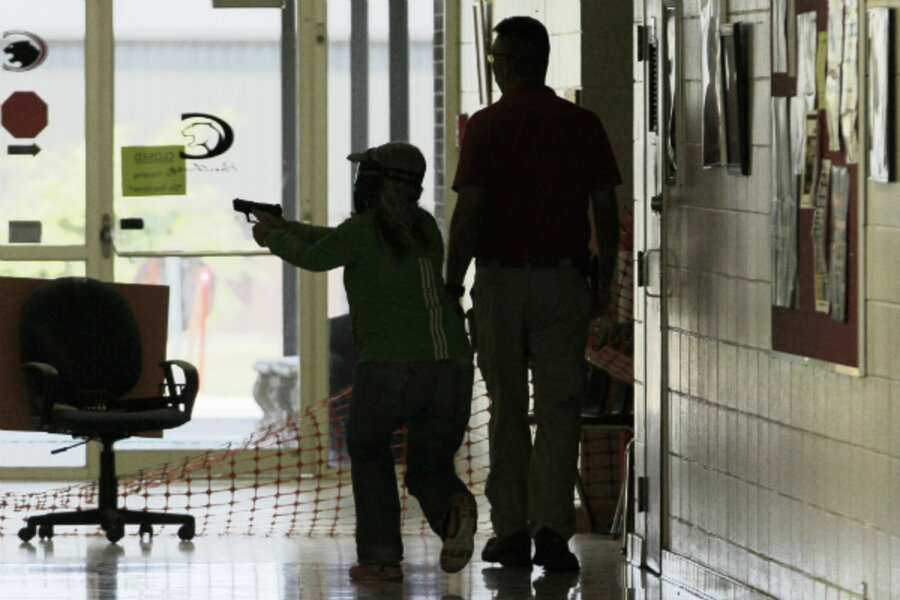Guns in schools: Arkansas district will arm 20 teachers and staff
Loading...
A small school district in Arkansas will arm 20 volunteer teachers and staff with handguns starting in the fall, reigniting debate about the best way to protect children in schools.
The district will be the first in the state to arm teachers and is doing so under a state law that allows licensed, armed security guards on campus. The school’s participants in the program, whose identities will be kept secret, will be considered security guards after undergoing 53 hours of training.
"The plan we've been given in the past is, 'Well, lock your doors, turn off your lights and hope for the best,' " Superintendent David Hopkins told the Associated Press. "That's not a plan.”
Mr. Hopkins said a wave of parent calls after the Sandy Hook Elementary School shootings last December caused him to reevaluate their procedures, even though the town of 9,200 people about 100 miles northwest of Little Rock isn't known for being dangerous.
State officials have not blocked the plan, even though Arkansas Education Commissioner Tom Kimbrell has said that he opposes arming teachers and staff. Instead, he supports hiring law enforcement officers as school resource officers.
Participating staff in Clarksville’s schools will be given a one-time $1,100 stipend to purchase a handgun and holster. The district will pay about $50,000 for ammunition and for training by Nighthawk Custom Training Academy, a private training facility in northwest Arkansas.
“That teacher is going to respond to one thing and one thing alone, and that's someone is in the building either actively or attempting to kill people," Jon Hodoway, director of training for Nighthawk said. "That's it. They're not going to enforce the law. They're not going to make traffic stops. If somebody is outside acting the fool, they're going to call the police."
At a recent training session teachers and administrators practiced using airsoft pellet guns to shoot a student pretending to hold another at gunpoint.
One of the student simulators, Sydney Whitkanack, said she’s not concerned about having teachers or staff armed.
"If they're concealed, then it's no big deal," she said. “It's not like someone's going to know, 'Oh, they have a firearm.' "
Others, like former president of the Arkansas Education Association Donna Morey, strongly opposed the plan, citing concerns over a student accidentally getting shot or taking a gun.
"We just think educators should be in the business of educating students, not carrying a weapon," she said.
The Clarksville school district is the latest example of localities trying to form responses to the Sandy Hook shooting last December that killed 20 children and six teachers.
Like Clarksville, some districts have decided to beef up armed security, in line with the National Rifle Association’s recommendation for every school to have an armed security guard, police officer, or staff.
In May, a rural Colorado school district voted to allow two top administrators to carry guns. They were able to circumvent Colorado’s gun laws by changing the job title of the superintendent to security officer. In Arizona's Maricopa County, Sheriff Joe Arpaio organized a posse of armed volunteers to patrol local schools, although he drew criticism for hiring a former child-sex offender.
In 2013, seven states passed legislation permitting teachers or administrators to carry guns in schools and more than 30 state legislatures introduced bills that would permit staff members to carry guns in public or private schools, according to the National Conference of State Legislatures.
But most proposals to arm teachers or staff have failed, even in conservative states more likely to support an expanded role for guns, according to The New York Times.
A key reason for fewer districts arming teachers is the potential cost, according to the Times report. Some insurance companies are declining coverage to schools that allow employees to carry handguns, or are raising their premiums.
In Kansas, for instance, the liability insurance provider for about 90 percent of Kansas school districts said it would not cover schools that permit employees to carry concealed handguns. A dozen Kansas school districts that were considering arming their staff changed their minds after the decision, the state employee who oversees insurance programs at the Kansas Association of School boards told the Times.
“Some [insurance providers] are saying this is so high risk we’re not going to touch it,” Kenneth Trump, the president of National School Safety and Security Services, which discourages districts from implementing concealed carry policies told the Times. “Others may say this is so high risk that you’re going to pay through the nose.”
• Material from the Associated Press was used in this report.








